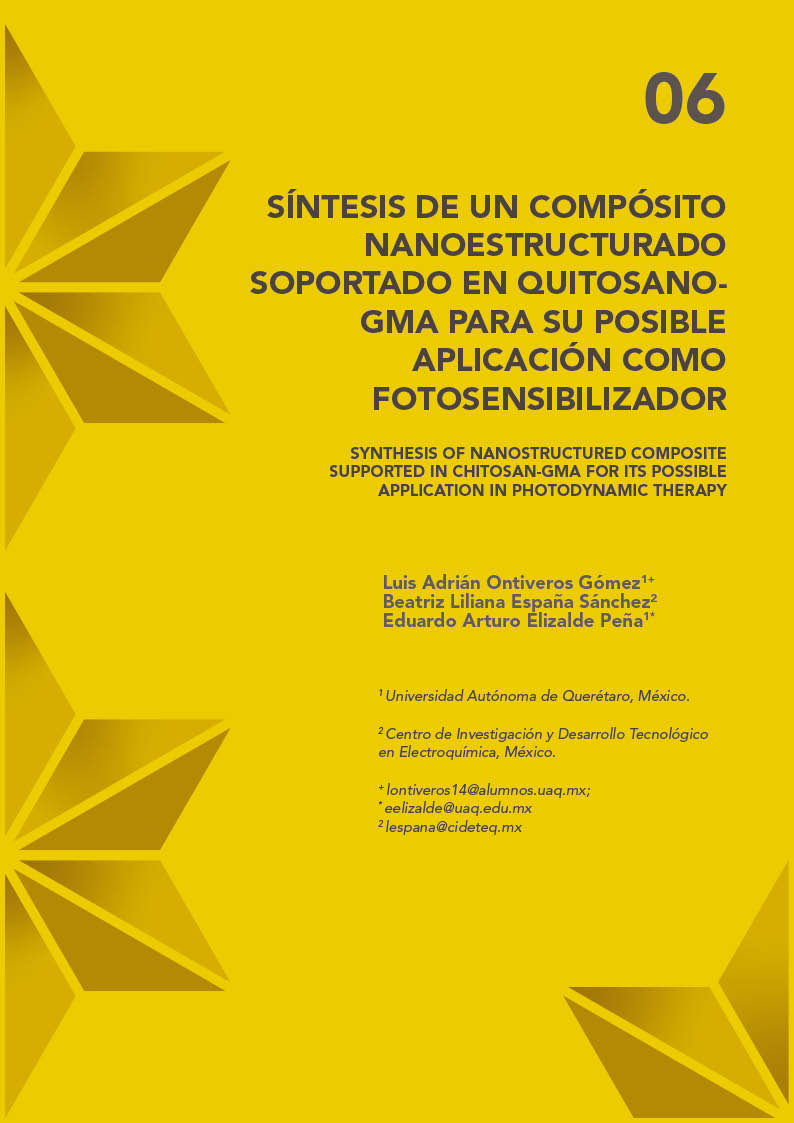Resumen
La terapia fotodinámica es una técnica alternativa para el tratamiento del cáncer y diversas enfermedades mediante luz, oxígeno molecular y un fotosensibilizador (Fs). Un Fs es una molécula especializada en absorber un fotón para estimular la promoción de un estado basal a un estado triplete excitado que, al encontrarse con oxígeno molecular, es capaz de producir especies reactivas de oxígeno. En el presente trabajo, se reporta la síntesis de un compósito nanoestructurado de nanoesferas de carbono (CNS) usado como fotosensibilizador conjugado con nanopartículas de oro (AuNPs) soportados en una matriz de quitosano-GMA (Q-GMA). Se observó por medio de las caracterizaciones de FT-IR, UV-VIS y SEM que los compósitos no alteraron la estructura de la matriz ni del plasmón característico de las AuNPs en las muestras de Q-GMA-CNS-AuNPs a 0.4 y 0.6 mM, los cuales son considerados como fotosensibilizadores potenciales para su aplicación en terapia fotodinámica.
Referencias
F. S. De Rosa and M. V. L. B. Bentley, “Photodynamic therapy of skin cancers: Sensitizers, clinical studies and future directives,” Pharm. Res., vol. 17, no. 12, pp. 1447–1455, 2000, doi: 10.1023/A:1007612905378.
G. B. Kharkwal, S. K. Sharma, Y. Y. Huang, T. Dai, and M. R. Hamblin, “Photodynamic therapy for infections: Clinical applications,” Lasers Surg. Med., vol. 43, no. 7, pp. 755–767, 2011, doi: 10.1002/lsm.21080.
S. Kwiatkowski et al., “Photodynamic therapy – mechanisms, photosensitizers and combinations,” Biomedicine and Pharmacotherapy, vol. 106. Elsevier Masson SAS, pp. 1098–1107, Oct. 01, 2018, doi: 10.1016/j.biopha.2018.07.049.
T. J. Dougherty, J. E. Kaufman, A. Goldfarb, K. R. Weishaupt, D. Boyle, and A. Mittleman, “Photoradiation Therapy for the Treatment of Malignant Tumors,” Cancer Res., vol. 38, no. 8, pp. 2628–2635, 1978.
D. Kessel, “Photodynamic therapy: From the beginning,” Photodiagnosis Photodyn. Ther., vol. 1, no. 1, pp. 3–7, 2004, doi: 10.1016/S1572-1000(04)00003-1.
T. C. Z. Haixia Qiu, Michael M. Kim, Rozhin Penjweini, Jarod C. Finlay, Theresa M. Busch, Tianhao Wang, Wenshen Guo, Keith A. Cengel, Charles B. Simone II, Eli Glatstein, “Comparison between different D-Dimer cutoff values to assess the individual risk of recurrent venous thromboembolism: Analysis of results obtained in the DULCIS study,” Int. J. Lab. Hematol., vol. 38, no. 1, pp. 42–49, 2016, doi: 10.1111/ijlh.12426.
J. M. Nauta et al., “Photofrin-mediated photodynamic therapy of chemically-induced premalignant lesions and squamous cell carcinoma of the palatal mucosa in rats,” Int. J. Oral Maxillofac. Surg., vol. 26, no. 3, pp. 223–231, 1997, doi: 10.1016/S0901-5027(97)80825-9.
C. M. Peterson, R. Reed, C. J. Jolles, K. Parker Jones, R. C. Straight, and A. M. Poulson, “Photodynamic therapy of human ovarian epithelial carcinoma, OVCAR-3, heterotransplanted in the nude mouse,” Am. J. Obstet. Gynecol., vol. 167, no. 6, pp. 1852–1855, 1992, doi: 10.1016/0002-9378(92)91786-A.
A. Chiaviello, I. Postiglione, and G. Palumbo, “Targets and mechanisms of photodynamic therapy in lung cancer cells: A brief overview,” Cancers (Basel)., vol. 3, no. 1, pp. 1014–1041, 2011, doi: 10.3390/cancers3011014.
M. C. García Vior, L. E. Dicelio, and J. Awruch, “Synthesis and properties of phthalocyanine zinc(II) complexes replaced with oxygen and sulfur linked adamantane moieties,” Dye. Pigment., vol. 83, no. 3, pp. 375–380, 2009, doi: 10.1016/j.dyepig.2009.06.006.
H. Abrahamse and M. R. Hamblin, “New photosensitizers for photodynamic therapy,” Biochemical Journal, vol. 473, no. 4. Portland Press Ltd, pp. 347–364, Feb. 15, 2016, doi: 10.1042/BJ20150942.
L. B. Josefsen and R. W. Boyle, “Photodynamic therapy: Novel third-generation photosensitizers one step closer?,” Br. J. Pharmacol., vol. 154, no. 1, pp. 1–3, 2008, doi: 10.1038/bjp.2008.98.
H. Kataoka et al., “New photodynamic therapy with next-generation photosensitizers,” Ann. Transl. Med., vol. 5, no. 8, pp. 1–7, 2017, doi: 10.21037/atm.2017.03.59.
J. Li, D. Guo, X. Wang, H. Wang, H. Jiang, and B. Chen, “The photodynamic effect of different size ZnO nanoparticles on cancer cell proliferation in vitro,” Nanoscale Res. Lett., vol. 5, no. 6, pp. 1063–1071, 2010, doi: 10.1007/s11671-010-9603-4.
S. J. He et al., “CdSe/ZnS quantum dots induce photodynamic effects and cytotoxicity in pancreatic cancer cells,” World J. Gastroenterol., vol. 22, no. 21, pp. 5012–5022, 2016, doi: 10.3748/wjg.v22.i21.5012.
K. D. Patel, R. K. Singh, and H. W. Kim, “Carbon-based nanomaterials as an emerging platform for theranostics,” Mater. Horizons, vol. 6, no. 3, pp. 434–469, 2019, doi: 10.1039/c8mh00966j.
T. Murakami, “Stimuli-responsive systems of therapeutics photodynamic action of single-walled carbon nanotubes,” Chem. Pharm. Bull., vol. 65, no. 7, pp. 629–636, 2017.
D. Chen et al., “Efficacy dependence of photodynamic therapy mediated by upconversion nanoparticles: subcellular positioning and irradiation productivity,” 2017, doi: 10.1002/smll.201602053.
G. M. F. Calixto et al., “Chitosan-Based Drug Delivery Systems for Optimization of Photodynamic Therapy: a Review,” AAPS PharmSciTech, vol. 20, no. 7, 2019, doi: 10.1208/s12249-019-1407-y.
D. S. Kwag, N. M. Oh, Y. T. Oh, K. T. Oh, Y. S. Youn, and E. S. Lee, “Photodynamic therapy using glycol chitosan grafted fullerenes,” Int. J. Pharm., vol. 431, no. 1–2, pp. 204–209, 2012, doi: 10.1016/j.ijpharm.2012.04.038.
D. P. Ferreira et al., “Characterization of a Squaraine/Chitosan System for Photodynamic Therapy of Cancer,” J. Phys. Chem. B, vol. 120, no. 7, pp. 1212–1220, Feb. 2016, doi: 10.1021/acs.jpcb.5b11604.
E. A. Elizalde-Peña et al., “Synthesis and characterization of chitosan-g-glycidyl methacrylate with methyl methacrylate,” Eur. Polym. J., vol. 43, no. 9, pp. 3963–3969, 2007, doi: 10.1016/j.eurpolymj.2007.06.004.
S. Pu, J. Li, L. Sun, L. Zhong, and Q. Ma, “An in vitro comparison of the antioxidant activities of chitosan and green synthesized gold nanoparticles,” Carbohydr. Polym., vol. 211, no. December 2018, pp. 161–172, 2019, doi: 10.1016/j.carbpol.2019.02.007.
D. K. Chatterjee and Y. Zhang, “Upconverting nanoparticles as nano-transducers for photodynamic therapy in cancer cells,” Tech. Proc. 2008 NSTI Nanotechnol. Conf. Trade Show, NSTI-Nanotech, Nanotechnol. 2008, vol. 2, pp. 69–72, 2008.

Esta obra está bajo una licencia internacional Creative Commons Atribución-NoComercial-CompartirIgual 4.0.
Derechos de autor 2023 Perspectivas de la Ciencia y la Tecnología

